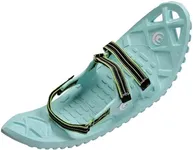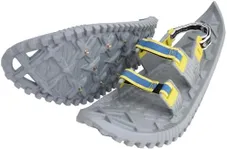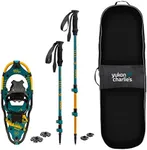Buying Guide for the Best Kids Snowshoes
Choosing the right pair of snowshoes for kids can make a big difference in their outdoor winter adventures. Snowshoes help distribute weight over a larger area, preventing the wearer from sinking into the snow. When selecting snowshoes for kids, it's important to consider their size, weight, and the type of terrain they will be exploring. Here are some key specifications to help you make an informed decision.SizeSize refers to the length and width of the snowshoe. This is important because it affects the snowshoe's ability to keep the child afloat on the snow. Snowshoes come in different sizes to accommodate various weights and snow conditions. For lighter kids or packed snow, smaller snowshoes are suitable. For heavier kids or deep, powdery snow, larger snowshoes are better. To pick the right size, consider the child's weight and the typical snow conditions they will encounter.
Weight CapacityWeight capacity indicates the maximum weight the snowshoe can support, including the child's weight and any gear they might be carrying. This is crucial to ensure the snowshoes provide adequate flotation. Snowshoes are often rated for specific weight ranges. For example, some may support up to 80 pounds, while others can handle up to 120 pounds. Choose a snowshoe with a weight capacity that matches or slightly exceeds your child's weight to ensure optimal performance.
BindingsBindings are the straps or mechanisms that secure the snowshoe to the child's boots. Good bindings are essential for comfort and stability. There are different types of bindings, such as ratchet, strap, and BOA systems. Ratchet bindings are easy to adjust and secure, making them a good choice for kids. Strap bindings are simple and reliable, while BOA systems offer quick and precise adjustments. Choose bindings that are easy for your child to use and that provide a secure fit.
TractionTraction refers to the snowshoe's ability to grip the snow and prevent slipping. This is important for safety, especially on icy or uneven terrain. Traction is provided by crampons or cleats located on the bottom of the snowshoe. For flat or gently rolling terrain, basic traction is sufficient. For steeper or icier conditions, look for snowshoes with more aggressive traction features. Consider the type of terrain your child will be exploring to determine the level of traction needed.
DurabilityDurability refers to how well the snowshoes can withstand wear and tear. This is important because kids can be tough on their gear. Snowshoes made from high-quality materials like aluminum frames and durable decking will last longer and perform better. Look for snowshoes with reinforced areas and sturdy construction. If your child is an avid snowshoer or tends to be rough on equipment, prioritize durability to ensure the snowshoes can handle their adventures.
Weight of the SnowshoesThe weight of the snowshoes themselves is important for comfort and ease of use. Lighter snowshoes are easier for kids to walk in and less tiring over long distances. However, very lightweight snowshoes may sacrifice some durability. Balance the need for lightweight snowshoes with the need for durability based on your child's activity level and the conditions they will be facing. For younger or smaller kids, prioritize lighter snowshoes to make their experience more enjoyable.





















